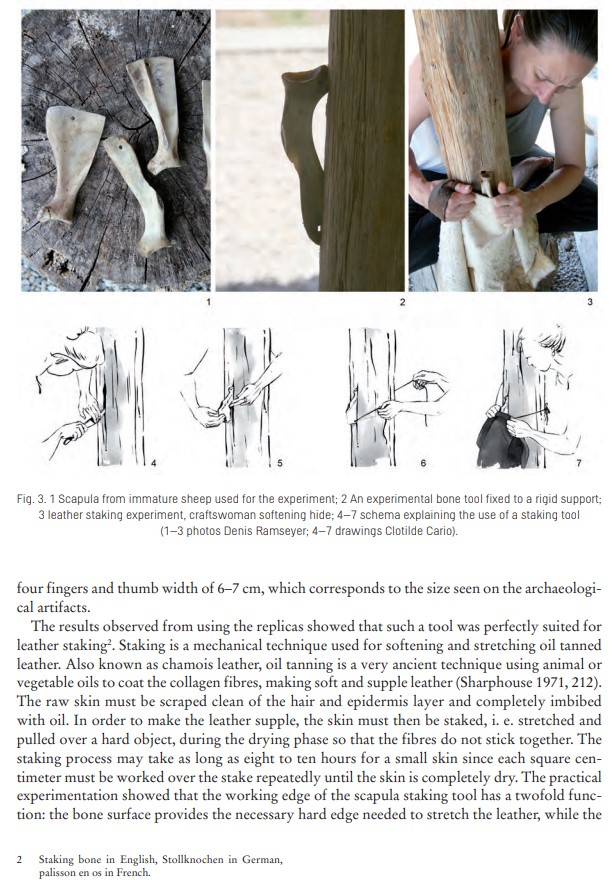Xiongnu bone staking tools of Boroo Gol 3rd C. BCE - 1st C. CE
"The Diet of the Xiongnu of Boroo Gol:
The Practice of Agriculture: There are few indicators of agriculture at Boroo Gol, but its practice is confirmed by the presence of millstones and rollers and even more so by the grains analyzed by Oerni Akeret, which originated from sieving activity while filling the pits situated around the excavated houses. The fact that cereal growing was practiced recently, i.e. during the communist era, around the site shows the fertility of this geographic zone. At the beginning of the 1990s, the sector to the west of the promontory of Boroo Gol was still covered by wheat fields, a practice that was abandoned around the turn of the century. Even today there is a farm and a freshwater well situated around 500 m away of Boroo Gol. Arable land is rare in Mongolia. Boroo belongs to one of these privileged zones and everything indicates that the Xiongnu did profit from this (Crumley 1994; Hayashi 1984).
The Practice of Livestock Breeding: Sheep and goat bones make up nearly 72% of the identified finds, whereas the cattle come third with a little more than 16%. These numbers correspond in general with the proportions of livestock of present-day populations. Horse bones come fourth with 6.7% of finds, i.e. around one hundred bony fragments, and dog fifth with 4.5% of the analyzed finds. Details of Sebastien Lepetz's analyses show that horses and dogs were eaten by the inhabitants of the village, but only rarely and parsimoniously. The presence of a pig (or a boar) is astonishing in such an environment - an isolated and unique case.
Burnt bones close to fireplaces, the luxation of long bones, skulls severed to extract the brain and the splitting of certain bones to extract the marrow all are indicative of similarities in the eating habits of the Xiongnu and those of present-day populations. The meat was cooked but not roasted, and tender meat was obtained by slaughtering young animals under the age of two. The study of the fauna reveals that the dairy farming was not a priority, but it is proven to have been extant by the presence of some ceramic cheese strainers.
Hunting, Fishing, and Harvest: Just a dozen of the 3,000 bony fragments analyzed came from wild animals. Hunting was indeed insignificant at Boroo Gol. This finding goes hand in hand with the small number of arrowheads found in situ: just two, made of bone. The metallic projectile points, triple-bladed broadheads, were surely reserved for war. As no systematic sieving was undertaken, it is difficult to estimate the share of fish in the diet of the Xiongnu. No physical traces remain, although the settlement is situated at the riverside and although the lakes are but a few hours away on horseback, which could have supplied the village with fish. To passionate meat eaters such as the Xiongnu, vegetables represented a minor share of their daily diet.
Leather Processing: The discoveries made in the frozen tombs in the Altai and in those of Noyon Uul have shown the importance of leather objects for daily life and its intense use in this ancient civilization of Central Asia. It is therefore not surprising to find traces of fur processing activities present on site.
The ethnographic studies which were carried out in Siberia and in the arctic regions show that leather processing is reserved for the women.
Systematic skinning of the slaughtered animals has been proven by the examination of the traces on the bony finds, an evidence which goes hand in hand with the fabrication of staking tools on-site and their use to make the leather supple and thinner or to prepare the furs."
-Denis Ramseyer, Role and Function of the Site of Boroo Gol (Töv, Mongolia). Central Asiatic Journal Vol. 59, No. 1-2, 2016.
Source:
Xiongnu Archaeology: Multidisciplinary Perspectives of the First Steppe Empire in Inner Asia
Quote:




Comments
Post a Comment